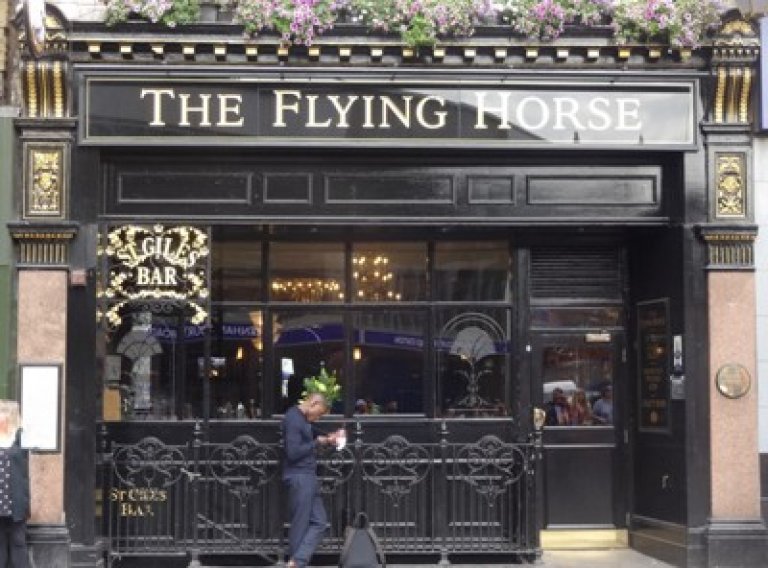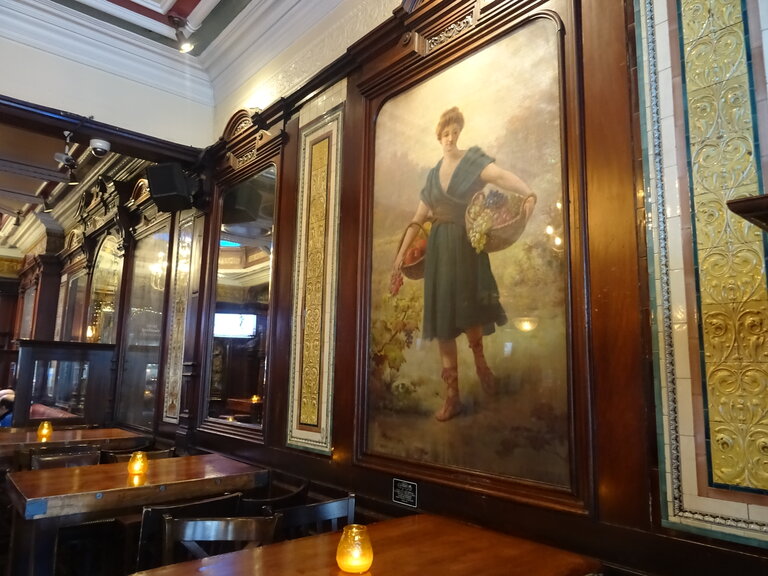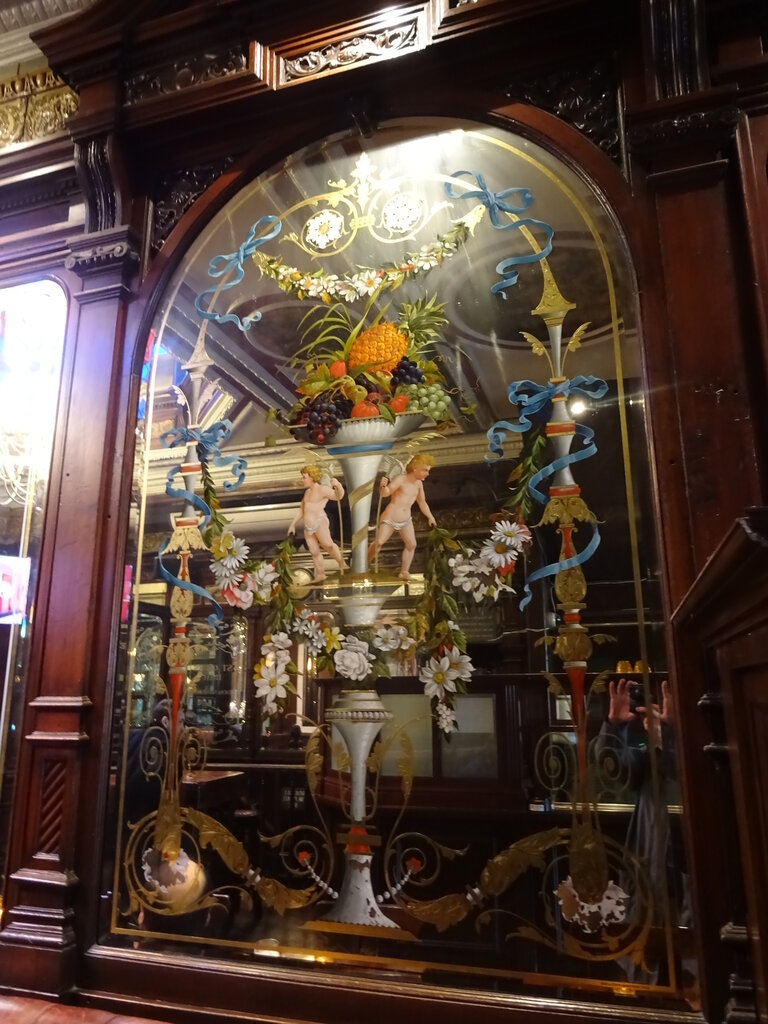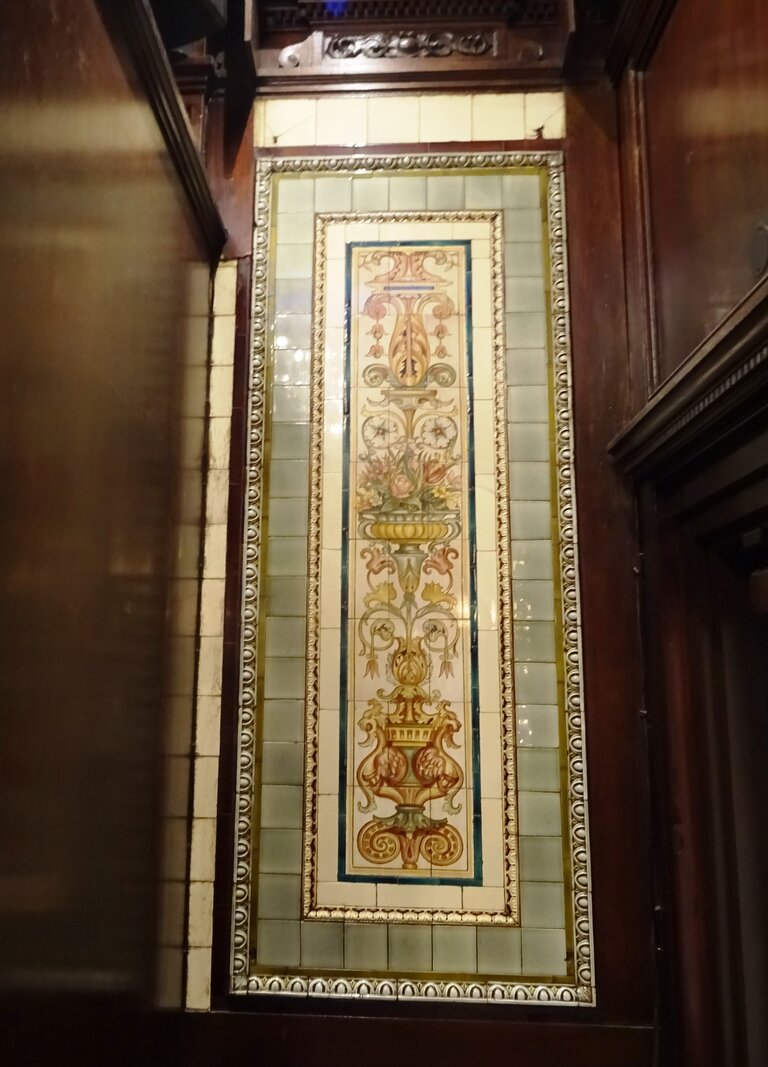Flying Horse
6 Oxford StreetFitzrovia
W1D 1AN
This pub is not only a grade II* listed building, it is also a Three Star pub on the Campaign for Real Ale’s (CAMRA) National Inventory with an interior of outstanding national historic importance, and the description is as follows: “Right by Tottenham Court Road Tube station, this is the last-remaining pub on Oxford Street. It was built in 1892/93 in a florid Flemish Renaissance style to the designs of architects Saville & Martin (who also designed the Punch Tavern, EC4) and occupies a narrow plot which no doubt reflects a long history. It was built for Baker Bros. (William Henry and Richard Baker), who epitomised the boom and bust world of late C19 public house speculation.
The pub now consists of a long, single space, which is the result of the amalgamation of two rooms from the original Victorian pub. Note there are two distinct parts to the ceiling - the front one has a modest frieze; the rear part has a tiled frieze and a skylight. Originally there would have been an entrance on the left that led to a passage to enter the rear room – note the ceiling mouldings at the front left which confirms this. The passage ran where the present bar back, bar counter and dumb waiter are situated. Head for the rear section to admire some of the most exceptional and rare Victorian pub fittings seen anywhere. The walls on three sides above the dado have carved mahogany pilastered panelling and within it is an impressive display of rare paintings; back painted mirrors; narrow panels of embossed tiling and some plain mirrors. The panelling also runs along the right hand side wall of the former front room. Just inside the front door there is the first of three back-painted mirrors; this one quite narrow and unfortunately mostly obscured by a games machine and wall-mounted TV. Then there's the first of a series of paintings which feature women representing three of the four seasons - this one is entitled ‘Autumn’ and is carrying grapes. (The fourth painting 'Winter' has disappeared, although it is just possible that it might have survived beneath the modern panelling beside the entrance). Either side of the first painting are panels of embossed tiles followed by a bevelled plain mirror. In the rear section (formerly the rear room as indicated by the ceiling) is a panel of encaustic tiles depicting flowering urns by Millington, Wisdom and Co, Art Tile Painters of Shaftesbury Avenue. Next is the second of the canvases of the Seasons featuring plump allegorical figures, ‘Summer’, carrying pheasants, signed by Felix de Jong and Co. Then there is the second of three back-painted mirrors: this one much larger than the other two, with ribbons, cherubs and cornucopia by Jones and Firmin who reintroduced this technique for decorating glass in the 1880s. Then a large plain mirror; then the second panel of encaustic tiles depicting flowering urns, and then next is the third of the rare paintings, ‘Spring’ carrying flowers; and lastly, tucked in a recess a tall narrow plain mirror in a tiled and ceramic frame. The rear wall is dominated by a large ornate mahogany-surround fireplace with an overmantle featuring three plain mirrors. To the left is the third of the back-painted mirrors, this being one of the pair of fairly small narrow ones and unfortunately now badly damaged.
The left-hand wall is also lined with carved mahogany panelling with large mirrored sections and small bevelled mirror sections at the top. In a recess at the rear of the left side is the fourth panel of encaustic tiles depicting flowering urns, which is in a tiled and ceramic frame. Above all of these rare features is a colourful tiled frieze with swirling foliage that runs all around the ceiling. Above the rear part of the room is an impressive large octagonal skylight with a tiled cornice; however modern coloured glass has been inserted. In the front half of the rear section there are two painted roundels depicting Classical scenes, also by de Jong. The much altered front room part has a modern bar counter. The bar back might be old but moved back from its original position and, in a similar style to the very different frieze treatment, it is plain and with modern mirrors. The dumb waiter is modern. On the extension to the bar counter that runs into the former rear room there is a simple reproduction of a set of snob screens. On the ceiling of the former front room are another four painted roundels depicting mythological scenes by de Jong. There is some tiling on the dado of the front section of the pub. The present window frontage is a later addition. Downstairs, now only accessible from the rear left of the main bar, is a room now the St Giles Bar, which has a modern bar counter and bar back.
The current pub was built on the site of a pub called the Flying Horse and in 2015 it changed its name to the Flying Horse after more than a century as the Tottenham.”
The listing description is as follows: “Public House (Formerly listed as The Tottenham Public House) 01-DEC-87 II* Public house, 1892, by Saville and Martin for the Baker Bros. Some later alterations including modern pub front.
EXTERIOR: a red brick building with stone banding and dressings in a Flemish Renaissance style. Its narrow frontage rises to four storeys plus a two storey gable, behind which is the steeply pitched slate roof. All the windows are timber sashes; some have transoms with coloured glass. The ground floor pub front and fascia are entirely modern but the pink granite corner pilasters with decorative consoles survive and above ground floor the building is largely unaltered. The first and second floor are defined by round-headed niches to the outer bays and a central canted bay window with pink granite colonettes, carved frieze and a gable feature breaking through into the third floor. The third and fourth storeys each have three segmental headed windows and the shaped gable to fourth and fifth floors has a broken pediment at its apex.
INTERIOR: not only survives extremely well, but also contains decorative elements that are more than special. The mahogany pilastered panelling, large fireplace with overmantle, colourful tiled frieze with swirling foliage, moulded cornice and heavily moulded ceiling with skylight are as robustly detailed and exuberant as those in the best late C19 public houses. The decorative panels mounted in the panelling are even rarer survivals and have more than special quality. There are three back-painted mirrors with ribbons, cherubs and cornucopia by Jones and Firmin who reintroduced this technique for decorating glass in the 1880s. There are panels of encaustic tiles depicting flowering urns by Millington, Wisdom and Co, Art Tile Painters of Shaftesbury Avenue. And there are three painted canvases of the Seasons, plump allegorical figures carrying pheasants, grapes and flowers, signed by Felix de Jong and Co (the fourth has been lost). The ceiling also contains painted roundels depicting Classical scenes, also by de Jong. The interior is relatively unaltered. While the bar is new, modern coloured glass inserted into the large octagonal skylight at the rear, and partitions have been removed to create a single open space of what were once at least two rooms, this remains one of the best-surviving late Victorian pub interiors in the country.
HISTORY: The Flying Horse was redeveloped on the site of an older pub at the same time as the large neighbouring block on the corner of Tottenham Court Road and Oxford Street. Although the two buildings were commissioned and erected simultaneously, there was never any interconnection between them and they remain separate addresses. Both are in the Flemish Renaissance style popular for commercial buildings and public houses at the end of the C19, a style which also suited the narrow plot widths on Oxford Street that had prevailed from the Georgian development of the road. When the Flying Horse was built it was located a few doors down from the Oxford Street Music Hall and there is something of the palace of varieties about its interior; indeed the decorators De Jong and Co were also employed at Frank Matcham's Hackney Empire. The Baker Bros were the late C19 publicans par excellence. William Henry and Richard Baker came to London from Devon with a few shillings between them and gradually built an empire of lavish public houses and hotels. The Flying Horse was one of their first speculations and they ran it personally from 1892-97; the adjoining building at 1a Tottenham Court Road was their offices. Although their enterprises ended in financial ruin, in the late 1890s they were masters of premises across London and several hotels in Leicester Square and the West End including the Grand Café de l'Europe, all but the latter designed by Saville and Martin who were pub specialists. Both became very rich and William, who rose to Lieutenant-Colonel in the Honourable Artillary Company, was considered to be 'a rather dandified man'; Richard was (according to Mark Girouard) 'flashier and financially closer to the wind'. This is the best-surviving of their remaining public houses.
REASONS FOR DESIGNATION: The Flying Horse Public House is listed at Grade II* for the following principal reasons: * its splendid interior which is one of the best-preserved in London and includes mirrors, mahogany panelling, an ornate fireplace and overmantle, ceramic frieze and embossed ceilings; * other elements of the décor are more than special survivals, in particular the paintings of the Four Seasons and ceiling panels, by De Jong and Co, the back-painted mirrors by Jones and Firmin and the panels of encaustic tiles depicting flowering urns by Millington, Wisdom and Co; * the exterior architecture is strong too and the exuberant Flemish Renaissance style chosen by Saville and Martin suits this tall, narrow frontage * one of the few remaining pubs built by the Baker Bros, who epitomises the boom and bust world of late C19 public house speculation and were men-about-town in their own day.” If the ground floor is crowded, there is more seating in the basement.
WhatPub link: Flying Horse/WhatPub
Pub Heritage Group Link: PHG/Flying Horse
The Flying Horse featured on the Evening Crawl of Soho on 13 December 2002, the Saints and Sinners: Evening Crawl of Covent Garden, Fitzrovia and Soho on 13 April 2016, and the Auntie's Boozers Revisited: Evening Pub Tour of Fitzrovia on 13 April 2022.







